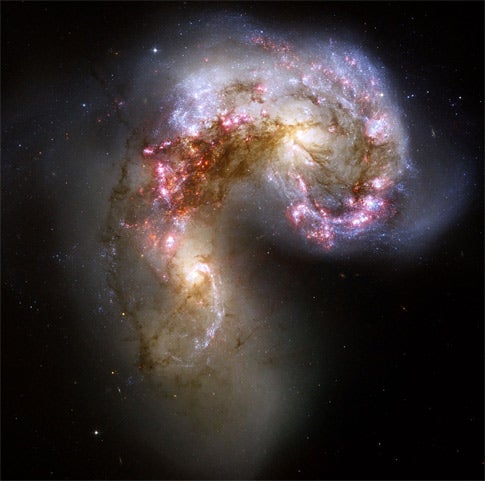The Antennae Galaxies are among the closest known merging systems. Also known as NGC 4038 and NGC 4039, the two began interacting a few hundred million years ago, creating one of the most impressive sights in the night sky. They are used by scientists as a standard against which to validate theories of galactic evolution.
An international group of scientists led by Ivo Saviane from the European Southern Observatory used Hubble’s Advanced Camera for Surveys and Wide Field Planetary Camera 2 to observe individual stars spawned by the colossal cosmic collision in the Antennae Galaxies. By measuring the colors and brightnesses of red giant stars in the system, the scientists found that the Antennae are much closer than previously thought: 45 million light-years instead of the previous best estimate of 65 million light-years.
The team targeted a region in the relatively quiescent outer regions in the southern tidal tail, away from the active central regions. This tail consists of material thrown from the main galaxies as they collided. The scientists needed to observe regions with older red giant stars to derive an accurate distance. Red giants are known to reach a standard brightness, which can then be used to infer their distance.
The previous distance to the Antennae Galaxy was about 65 million light-years, although values as high as 100 million light years have been used. Our Sun is only 8 light-minutes away from us, so the Antennae Galaxies may seem rather distant. But if we consider that we already know of galaxies more than 10 billion light-years away, the two galaxies are really our neighbors.
The new, smaller distance makes the Antennae Galaxies less extreme in terms of the physics needed to explain the observed phenomena. For instance, its infrared radiation is now that expected of a standard early merging event rather than that of an ultraluminous infrared galaxy. The size of the star clusters formed as a consequence of the Antennae merger now agree with those of clusters created in other mergers instead of being 1.5 times as large.
The Antennae Galaxies are named for the two long tails of stars, gas and dust that resemble the antennae of an insect. These “antennae” are a physical result of the collision between the two galaxies. Studying their properties gives us a preview of what may happen when our Milky Way Galaxy collides with the neighboring Andromeda galaxy in several billion years.










